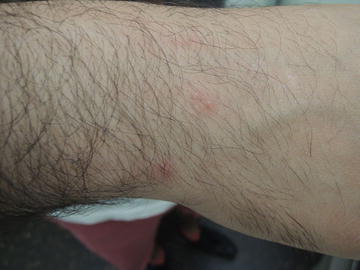, Corinna Eleni Psomadakis2 and Bobby Buka3
(1)
Department of Family Medicine, Mount Sinai School of Medicine Attending Mount Sinai Doctors/Beth Israel Medical Group-Williamsburg, Brooklyn, NY, USA
(2)
School of Medicine Imperial College London, London, UK
(3)
Department of Dermatology, Mount Sinai School of Medicine, New York, NY, USA
Keywords
Bug biteArthropodSpiderFleaTickWaspBeeStingHymenopteraMosquitoAllergyAllergicAnaphylaxisAntihistamineTopical steroid
Fig. 14.1
Erythematous wheals with a raised, edematous central papule on the wrist

Fig. 14.2
Briskness of immune reaction will dictate the size of these lesions. It is, therefore, impossible to name the culprit based on the morphology of the lesion
Primary Care Visit Report
A 26-year-old male with no past medical history presented with a rash on bilateral arms and wrists. The patient had woken up with the skin lesions 1 day prior. They were very itchy. They had gotten progressively worse since they appeared and seemed to become more symptomatic after he showered. The patient applied topical Benadryl cream which did not help.
Vitals were normal. On exam, there were multiple scattered erythematous papules with some excoriations on bilateral arms. There were no lesions in the web spaces of his fingers and no burrows. His right arm had an area of linear lesions, otherwise the lesions were diffusely scattered.
The lesions seemed to be bites; however, Primary Care was unsure of the source. The patient was treated for scabies with permethrin cream, and referred to dermatology in case the lesions did not clear up.
Discussion from Dermatology Clinic
Differential Dx
Arthropod bites
Scabies
Urticaria
Folliculitis
Favored Dx
On physical examination, the lesions appear to be arthropod bites. The phylum arthropods includes centipedes, millipedes, spiders , scorpions, and insects. The offending biter is difficult to identify without more details from the history, such as whether the individual has any pets (could suggest flea bites), if anyone else in the house has bites (scabies, fleas, or bed bugs), or whether he spent time outdoors with his arms exposed (mosquitoes , outdoor bugs). The distribution of the bites would not be typical of scabies, which tend to appear around the wrists and interdigital spaces. Furthermore, scabies lesions typically feature more extensive excoriation.
Overview
Arthropod bites are a significant cause of morbidity worldwide [1]. Arthropod bites and stings cause a range of symptoms in humans, ranging from mildly uncomfortable to life threatening. The majority of arthropod bites cause local reactions; however, some bites can cause toxic and anaphylactic reactions [2]. Many arthropods serve as vectors for diseases such as malaria, dengue, West Nile virus, Rocky Mountain spotted fever, Southern tick-associated rash illness (STARI), and Lyme disease.
The species of concern in the USA include the black widow and brown recluse spiders , the lone star, black-legged (Ixodes scapularis) and dog ticks, bed bugs, fleas , biting flies, and mosquitoes . Their significance is due to prevalence, severity of bite symptoms, or potential to transmit disease [1, 2]. Specifically, black widow spider bites cause severe muscle spasms and brown recluse spider bites can cause skin necrosis. Tick and mosquito bites are common, and the species are vectors for a number of diseases named above.
Stay updated, free articles. Join our Telegram channel

Full access? Get Clinical Tree








